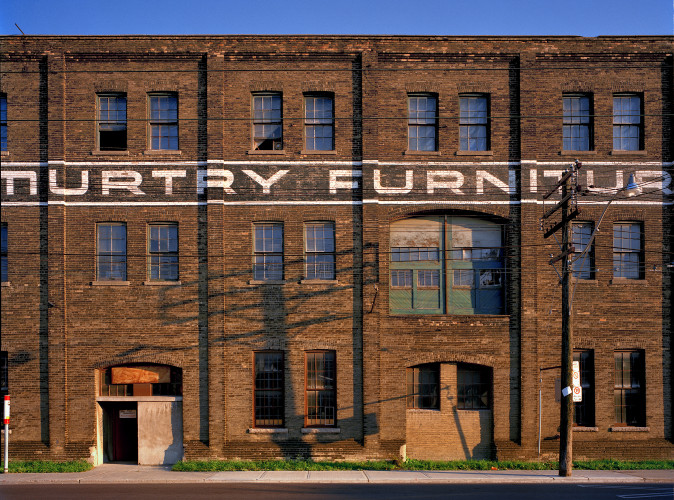Photography Exhibition Tells A Tale of Two Cities
Many of the ‘eccentric’ buildings of Toronto and Montreal have already gone
by MARTIN KNELMAN
From The Toronto Star, May 11, 2006
The late Jane Jacobs, who loved taking walks through many of Toronto’s more modest neighbourhoods, would have loved David Kaufman’s intriguing photography exhibition The Disappearing City.
Kaufman puts the spotlight not on huge well-known buildings like the Inn on the Park, which was shockingly obliterated this week, but on the kind of small, eccentric buildings that help give a city and a downtown neighbourhood its flavour.
But many of them, as the title of the exhibit suggests, are just as much an endangered species as the Inn on the Park. Some have been torn down since Kaufman photographed them, while others have fallen into states of disrepair and neglect.
“The buildings I like to photograph are rapidly disappearing from the centres of our major cities,” says Kaufman. “It was these buildings that gave cities their distinctive feel in the mid-twentieth century.”
Their disappearance, along with the predominance of shopping centres and strip malls, along with a sharper division of residential and commercial areas, have made Canada’s two largest cities feel more and more like intensely concentrated suburbs, Kaufman says.
The show — which consists of photographs Kaufman has been taking for more than 20 years, mostly in Toronto and Montreal — is running until May 28 as part of the Contact Festival.
The venue, appropriately, is the Bliss Gallery East in a non-glamorous part of the city — just off Queen Street East, west of Greenwood — for which Kaufman has an obvious fondness.
Kaufman has spent most of his career as a documentary filmmaker, mostly for CBC’s flagship information programs The Journal and the fifth estate.
But his avocation has always been architecture-based photography. Among his special interests: Montreal’s old synagogues, Mt. Pleasant Cemetery’s arboretum, and portraits of Klezmer musicians shot over seven summers at an annual festival in the Laurentians north of Montreal.
Kaufman’s foray into photography began as a kind of love letter to the Montreal of his childhood. He grew up in the 1950s in Ville St. Laurent before it had been turned into a suburb.
The Disappearing City is a tale of two cities focusing partly on the city where Kaufman grew up and partly on the one where he has spent most of this adult life.
The exhibit’s title refers to buildings in both Montreal and Toronto that have certain things in common. They’re the kinds of buildings that Kaufman loves to photograph, and the kinds one finds in the oldest parts of those cities. And they’re the kinds that are vanishing.
Typically they are factories, store fronts, commercial and institutional facilities built in the late 19th century or early 20th century.
About half the buildings photographed for this show have literally disappeared, says Kaufman. Among them: the old McMurtry Furniture factory on Dupont and A.R.C. industry building on Eastern Ave.
“All of them were beautiful in their own way, and some deserved to be preserved. Some, like the Symes Avenue generating station, are falling down from neglect. Others, like the R.C. Harris filtration plant, are now off-limits to the public.”
In the past decade or so, architectural photography has been embraced, especially in large U.S. cities, by those who care about preservation and the urban environment. But according to Kaufman, it still hasn’t been given its due in the world of fine-art photography.
Kaufman’s images add up to the story of how large cities, once animated by industrialization, have been going through a slow process of de-industrialization. The consequences are more shockingly apparent in certain U.S. cities such as Detroit and Newark, where huge portions of the city core have been abandoned.
One difference between Montreal and Toronto is that Montreal — which in 1945 had four times as large a population as Ontario’s capital — had a much bigger stock of heritage buildings.
“Montreal was no better at preserving its buildings than Toronto. But more of these buildings survived there. And photography became an important weapon in the fight to save them.”
Of course not all old buildings can be preserved. In some cases, it is hard to make them commercially viable.
“The best thing that can happen to one of these buildings,” says Kaufman, “is to be turned into a condo.”

McMurtry Furniture Factory, Dupont Street, Toronto, August 1996
